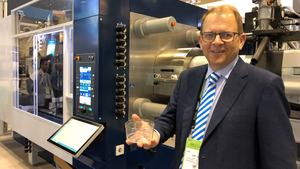By Design: The competitive edge
April 1, 1997
|
In this bimonthly column, Glenn Beall of Glenn Beall Plastics Ltd., Libertyville, IL, shares his special perspective on issues important to design engineers and the molding industry.
The custom injection molding business is prospering, but there are dark clouds on the horizon.
More and more original equipment manufacturers (OEMs) are learning how to reduce their costs by buying offshore. One OEM now purchases more than 1.2 billion molded parts in China. U.S. material manufacturers and processors are opening facilities in Mexico, South America, and Asia. Foreign processors are establishing huge plants in this country. Some of these operations are justified by the multinational transportation industry's desire to reduce its global supplier base. History indicates that the other OEMs will follow the example set by the car companies. These transplanted processing facilities will look for nonautomotive work once they saturate that market, lose a contract, or experience a recession. At a steady rate, injection molding companies are being auctioned off, bought out, or merged into larger multiservice organizations.
Unrealistic Expectations
Simultaneously, there has been what many people believe is an unrealistic increase in customer expectations. Every single project is now expected to be at the lowest possible cost, the highest possible quality, in the shortest possible time - and with a smile. The old "as soon as possible" phrase, which used to be reserved for special situations, has now become standard operating procedure. What do we use now for special situations?
Competition for the remaining domestic market is fierce. Molders find themselves selling in a buyer's market. Customer expectations and competition will continue to increase. No intelligent person expects to return to the good old days, when doing business for a profit was fun.
Survival of the Fittest
How are custom molders to survive if profit margins continue to decline and competition becomes more intense? Competition will increase, and the best of the custom molders will prosper.In the final analysis, all injection molders do the same thing. They mold parts to a level of delivery, quality, and cost that someone is willing to pay for. All molders may do the same things, but there is a big difference in the way they do them.
As molders search for ways to survive in a global economy, they should consider that the parts they mold are always made up of four basic elements: the design of the part, the material, the tooling, and the molding. (See 'The four elements of a successful product," February 1997 IMM, p. 44.) There are many other things that are required to produce a molded part, but these four elements will always be present.
The Constants
Normally, all of the competitors receive the same design or part drawing when they are invited to submit a proposal.
Material. When an OEM specifies a designated plastic, the material becomes a constant for all competitors. If a material is not specified, all molders can select and buy the same material on the open market. One molder may strike a better deal with a resin or pigment supplier. Another may buy in larger quantities. An enterprising competitor might have the material specially compounded to improve its moldability, or to incorporate a less costly filler or recycled material. These options and others are, however, available to everyone who is competing for the business. The material is, or can be, a constant.
Tooling.Each custom molder has his own approach to tooling. Some have captive tool building operations. With a few exceptions, those same tooling capabilities are available in the open market. Some molders purchase only foreign-built molds. Others favor large cavitation. Some strive for efficient molding by investing more in the tool - positive part ejection and extra cooling, for example. Others settle for a higher part cost as they strive for the lowest tooling cost.
All competitors can, however, specify the same tooling features and purchase their tooling from the same moldmakers. Tooling is, or at least can be, another constant.
Molding. There are many types and ages of injection molding machines in use today. A new molding machine is normally better than an old machine, but not all parts have to be produced on a new, high-tech machine. Some machines perform some functions better, or more consistently, than others. In simplistic terms, injection molding machines do only two things. They melt and move plastic material from one place to another, and they open and close a mold. All injection molding machines perform these same functions. All of these different kinds of machines are available on the open market. All of the molders who are competing for the same business can use the same kind of machines if they so choose. It isn't the molding machines, but how the molder uses that machine, that is the qualifying factor.
Some processors do a better job of molding than others. The differences among molders are primarily the result of the company's management philosophy and the accumulated knowledge of its staff. There is, however, nothing that prevents any molder from training and upgrading his staff. All custom molders can hire a processing engineer from Ferris State or Lowell. In the final analysis, all competing custom injection molders can acquire the same molding equipment and staff.
The Variable
Design, however, is unique. Each part design is different. Part design is normally specified by the customer and it is outside of the molder's control. If all competing molders quote the same part drawing, the design is also a constant. But it doesn't have to be that way.
Today, OEMs are more open to suggestions for efficiency-improving design changes than at any time in the past 30 years. OEMs have come to realize that their designs have to be improved in order for them to prosper in a global economy. The best way for a molder to help his customer and himself design parts that are properly proportioned for economical tooling and molding is by ESI, or early supplier involvement.
If the molder is involved with his customer's design team early in the project, the part drawings can be done right the first time. This is better than making last-minute design recommendations after the drawings are finalized and the designer is assigned to another project. Early supplier involvement is the best, but the next best approach is to fine tune the design at the time the project is being quoted.
Overcoming Resistance to Change
OEM designers dread having their designs changed late in a project. Buyers want all suppliers to quote the same way for easy comparison. One proven way of overcoming this resistance to change is to submit a two-part quote. The first part is based on the drawing as received. The second part, with a lower piece part and/or tooling cost, is based on an improved design.
There are greedy OEMs who cannot resist the temptation of requoting the improved design with other molders. It only takes one or two projects to determine an OEM's style. If this happens, the molder has only lost some time in determining that the OEM is unethical. Thereafter, he treats the OEM in the standard adversarial way, where each party is expected to take advantage of the other if given a chance.
The Competitive Edge
If all molders receive the same drawing to quote, most will simply quote the part as drawn, according to the tried and proven principle of giving the customer what he asked for. The enterprising molder, looking for a competitive edge, could recognize this as an opportunity. He could search for ways to improve the design and his ability to compete.
For example, will providing draft angle on the side cored surfaces shorten cycle time? Can the addition of radiuses and a slightly thicker wall allow the use of a weaker, lower cost material? Would a slight design change allow the threads to be located on a parting line to reduce tooling cost and the cycle time required for an unscrewing mold? If the molder taking this approach is successful in making the new part more efficient to produce, he will have a competitive edge over the molders who took the easy approach and quoted the part as drawn.
The material, tooling, and molding elements of an injection molded part are usually constants for everyone competing for the business. Today, it is unfortunate (but true) that there are many improperly designed parts being released for production. One good place to look for a competitive edge is in improving the design of these parts. Any molder who starts with a better part design than his competitors will enhance his chances of future survival and prosperity.
You May Also Like



